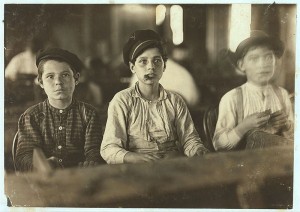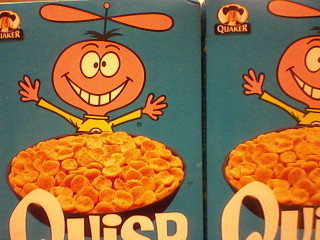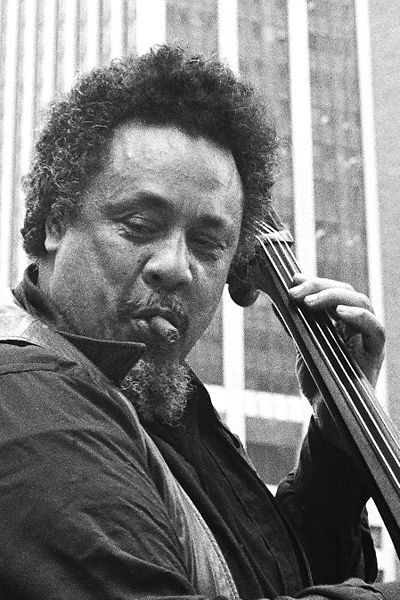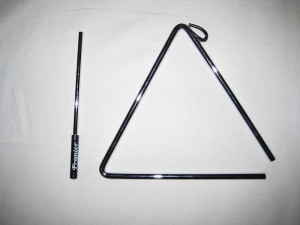From New Zealand. (Thanks Endgadget.)
You are currently browsing the archive for the Videos category.
Stewart Brand adapted his 1995 book, How Buildings Learn, into a 1997 BBC TV sepcial.
More Stewart Brand Posts:
Tags: Stewart Brand
Theoretical cosmologist Sean Carroll explains to Steven Colbert the idea of the Multiverse, the theory that multiple universes make up all that exists.
•••••••••
The Mulitverse Theory via Family Guy:
Tags: Sean Carroll, Steven Colbert
I was shopping in a supermarket recently and noticed a mountain of Quisp cereal, an erstwhile dead brand that was originally introduced in 1965. It reminded me of Rob Walker’s excellent 2008 Sunday Times Magazine article about River West Brands, a Chicago outfit that purchases and reivitalizes ghost products, including the sugar-coated flying saucer cereal, hoping to capitalize on nostalgia and brand familiarity. An excerpt from Walker’s article:
“River West’s offices, on the 36th floor of the Chicago Board of Trade Building, are sprinkled with the bric-a-brac of obscure products: a Quisp cereal box, Ipana toothpaste packages, Duz detergent bottles. On a wall of Paul Earle’s office is a framed, five-foot-by-three-foot sheet of uncut ‘Wacky Packages’ stickers — those 1970s trading-card-size brand-parody images that rendered the word Crust in the style of the Crest logo, for example. Earle has a Midwestern everyman quality about him: he’s compact, with a big and friendly let’s-get-along voice and a penchant for deadpan jokes. Only his designer-eyeglass frames deviate from his overall demeanor.
Earle loves brands. They are not mere commercial trademarks to him, but pieces of Americana. He seems not just nostalgic but almost hurt about the fate of the ‘castoff brands’ of the world. ‘If commerce is part of the American fabric, then brands are part of the American fabric,’ he said to me on one occasion. ‘When a brand goes away, a piece of Americana goes away.’
Earle’s professional entanglement with branding began at Saatchi & Saatchi, where he was a cog in a gigantic ad agency working for gigantic clients, like General Mills and Johnson & Johnson. That was in the mid-1990s, and he saw what happened as conglomerates merged: brands that didn’t have the potential for global scale got squeezed to the bottom shelf, or out of existence. He was attracted to the idea of working with ‘noncore’ brands, but when he figured out that big-agency economics made it impractical, he left Saatchi and went to the Kellogg School of Management at Northwestern University, and then took a brand-management job at Kraft.
At Kraft he observed the same mergers-and-consolidation process from a different angle, and he seems to have found it equally frustrating. ‘These are American icons with loyal consumers,’ he says. ‘It’s not their fault a $40 billion company doesn’t like them anymore. Consumers like them.’ He sees reviving brands as ‘a civic mission’ of sorts. ‘If it weren’t my job,’ he said, ‘it would be my hobby.’ He says this in a way that sounds not just plausible but hard to doubt.
Even so, he has set out to make this particular civic mission turn a profit. While he recognizes that a given brand might not be able to survive in the portfolio of a multinational, different sorts of business models might work to sustain it. As surely as the ownership of brands has consolidated through one megamerger after another, the consumer market seems to be moving in the opposite direction, with an individualism-fueled demand for almost unlimited variety.”
______________________
The cereal from Planet Q:
Tags: Paul Earle, Rob Walker
There was a ridiculous and popular 1968 book by Erich Von Daniken, called Chariots of the Gods?, that was turned into a 1970 film by Harald Reinl. It proposed that extraterrestrial astronauts visited Earth and influenced history. This video, a TV reedit of the film, is narrated by Rod Serling.
Tags: Erich Von Daniken, Harald Reinl, Rod Serling
Newly opened at the University of Chicago. (Thanks Singularity Hub.)
One of the first machines to convert solar power to electricty. If you’re going to do nothing, do it like this.
Tags: Charles Eames, Ray Eames

"He was literally and figuratively behind the wheel of our bus, driving it the way Charlie Parker worked the saxophone." (Image by Joe Mabel.)
In a 1994 Paris Review Q&A, Ken Kesey explains how Beat muse Neal Cassady wound up driving Furthur, the Merry Pranksters’ bus:
“Cassady was around us often. There was one incident in particular when he truly impressed me not only as a madman, genius, and poet but also as an avatar—someone in contact with other powers. He took me to a racetrack near San Francisco. He was driving and talking very fast, checking his watch frantically, hoping we would get to the track on time. If we got to the track just before the last three races, we’d get in free. We made it just in time and we bet on the last two races. Cassady had a theory about betting he’d learned in jail from someone named Knee-Walking Jackson. His theory was that the third favorite at post time is often the horse most likely to upset the winner and make big money. Cassady’s strategy was to step up to the tellers at the ticket booths just at post time. He’d glance up to see who was third favorite and put money on that horse. He didn’t look at the horses, the jockeys, or the racing sheets. He said to me, This is going to be the one, I can feel it. He asked me for ten bucks and I gave it to him. He put three dollars down with my ten. Given the odds we would have made some good money. We went right down to the line to watch, and it was a close race, neck and neck. I’m no horse fan, but I was getting into it because it looked like the third favorite could win. There was a photo finish and Cassady suddenly tore up his tickets and left. I followed him back to the car and could hear the announcement: We have a photo finish and the winner is . . . It turned out to be the favorite. Neal was so confident of his vision that if he lost, he never waited around or looked back.
Cassady was a hustler, a wheeler-dealer, a conniver. He was a scuffler. He never had new clothes but was always clean, and so were his clothes. He always had a toothbrush and was always trying to sell us little things and trying to find a place where he could wash up. Cassady was an elder to me and the other Pranksters, and we knew it. He was literally and figuratively behind the wheel of our bus, driving it the way Charlie Parker worked the saxophone. When he was driving he was improvising an endless monologue about what he was seeing and thinking, what we were seeing and thinking, and what we had seen, thought, and remembered. Proust was his literary hero and he would quote long passages from Proust and Melville from memory, lacing his revelations with passages from the Bible. He was a great teacher and we all knew it and were affected by him.”
••••••••••
Cassady in conversation with Allen Ginsberg, 1965:
Tags: Allen Ginsberg, Ken Kesey, Neal Cassady
This classic 1976 photograph shows the tempestuous musical genius Charles Mingus playing in Manhattan as part of the celebration for the two hundredth anniversary of the signing of the Declaration of Independence. Mingus would live just three more years, passing away from ALS in 1979. From a 1971 Ebony article about the musician’s memoir:
“In his offbeat autobiography, Beneath the Underdog: His World as Composed by Mingus, the noted composer, bassist and general enigma of that name contends that he is really three people. One man stands at dead center, cooly surveying his domain and expressing what he sees to the other two, one of whom is prone to strike out like a frightened animal while the other is gentle and painfully vulnerable. While it is not quite clear as to which self wrote this “Sex Machine” of a book (possibly it was the middle man since he speaks of himself in the third person), it is interesting to note that one might find elements of all these selves in this man’s music. Mingus composes and plays like a beleaguered genius challenging some nameless deity to account for the inequities imposed on the man by fate and other men–and to do so in no uncertain terms. He is a music of storm and constant questioning, beauty, brilliance and embracing tenderness, all of it molded on a framework of logical musical order. It is difficult to think of any ‘jazz’ artists, aside from Mingus’ idol, Duke Ellington, who is capable of creating such impressionistic tapestries of shimmering sound. In other words, Charles Mingus is one of the truly great ones, beneath the layer of legends surrounding his sexual exploits and eccentricities. His genius must be acknowledged.”
••••••••••
Silent super-8 footage of Battery Park celebration on July 4, 1976:
Tags: Charles Mingus
J.G. Ballard speaking the truth in 1986. Seemingly even more spot-on today, though exhibitionism is now as much of a diversion as violence.
Tags: J.G. Ballard
“The Boy in the Bubble”
It was a slow day
And the sun was beating
On the soldiers by the side of the road
There was a bright light
A shattering of shop windows
The bomb in the baby carriage
Was wired to the radio
These are the days of miracle and wonder
This is the long distance call
The way the camera follows us in slo-mo
The way we look to us all
The way we look to a distant constellation
That’s dying in a corner of the sky
These are the days of miracle and wonder
And don’t cry baby, don’t cry
Don’t cry
It was a dry wind
And it swept across the desert
And it curled into the circle of birth
And the dead sand
Falling on the children
The mothers and the fathers
And the automatic earth
These are the days of miracle and wonder
This is the long distance call
The way the camera follows us in slo-mo
The way we look to us all
The way we look to a distant constellation
That’s dying in a corner of the sky
These are the days of miracle and wonder
And don’t cry baby, don’t cry
Don’t cry
It’s a turn-around jump shot
It’s everybody jump start
It’s every generation throws a hero up the pop charts
Medicine is magical and magical is art
The boy in the bubble
And the baby with the baboon heart
And I believe
These are the days of lasers in the jungle
Lasers in the jungle somewhere
Staccato signals of constant information
A loose affiliation of millionaires
And billionaires and baby
These are the days of miracle and wonder
This is the long distance call
The way the camera follows us in slo-mo
The way we look to us all
The way we look to a distant constellation
That’s dying in a corner of the sky
These are the days of miracle and wonder
And don’t cry baby, don’t cry
Don’t cry
Tags: Paul Simon
For some reason in 1973, more Americans than usual imagined they were seeing UFOs. Maybe after trips to the moon, we thought we were due a visit of our own? Maybe the Vietnam-and-Watergate era was so surreal that everything felt alien anyway? Governor John Gilligan of Ohio, who thought he saw a saucer, is, of course, the father of Kathleen Sebilius, the current Secretary of Health and Human Services.
Tags: John Gilligan, Kathleen Sebilius, Walter, Walter Cronkite
The Musalman, a four-page evening paper, published in India since 1927.
Dropping acid, making pottery, surfing waves, studying Tarot, etc. A thoughtful look at California hippies, particularly one named Tom, in 1973.
Tags: Tom
Kentucky Fried Chicken was oddly allowed to briefly operate two restaurants in Russia during the frost of the Cold War in the 1960s.
An experimental 17-minute BBC version. Better than Cronenberg’s 1996 adaptation, I think.
From a piece about Ballard in the Los Angeles Times by David L. Ulin: “If J.G. Ballard — the visionary British novelist who died Sunday of prostate cancer at age 78 — ends up being remembered, it will likely be as a science fiction writer who aspired to use genre as a vehicle for art. That’s true enough, in a certain small-bore manner, but it’s ultimately reductive, a way of categorizing Ballard that his entire career stood against.
A member of the New Wave science fiction movement of the 1960s, Ballard started out writing proto-environmental thrillers that highlighted the prescience of his imagination: The Wind From Nowhere posits a world-wide windstorm that becomes apocalyptic, while The Drowned World is about a planet swamped by risen sIt was really in the 1970s, however, that Ballard found his voice as a writer, focusing on the dangers of mechanization and socialization, the tension between the veneer of civilization and the animal brutality it sought to conceal. “

"Everybody has seen these little waifs at watering places, on cars, steamers, and to every crowd of people where there was a chance to earn a few pennies." (Image by Lewis Hine.)
The August 21, 1873 edition of the Brooklyn Daily Eagle published a disturbing story about a child-smuggling ring that supplied New York City ringleaders with waifs to play music on the street and earn money. An excerpt:
“The examination of the case of Vincenzo Motto, of 45 Crosby Street, New York, who is charged with violation of the Civil Rights bill by kidnapping Italian children, bringing them to this country and compelling them to earn a living for him by performing on instruments in the streets, was resumed yesterday before Commissioner Osborn, in the United States District Court, New York. Everybody has seen these little waifs at watering places, on cars, steamers, and to every crowd of people where there was a chance to earn a few pennies by rasping “Old Dog Tray” and kindred tunes out of a cracked violin in the most persistent manner. It is only recently, however, that public attention has been called to the secret history of their lives here and the cause of their presence.
Some time since one of these little musicians ran away from the ‘padrone’ with whom he lived, and by whom he was brought to the country, and from the statements made by him to authorities, it appeared that all these little musicians were owned by a company in New York. They had agents in Italy, who purchased the children from their parents, and when that was not possible, kidnapped them, and sent them out here consigned to some padrone who was a member of the fraternity, and who owned when as much as any slaveholder ever owned his negro.
The unfortunate children, who were subjected by the lazy padrones in order to make them return so much money every day, excited a storm of public indignation, and it is expected that the present proceedings will result in breaking up the whole thing and emancipating hundreds of these unfortunate little fellows, from their brutal taskmasters.
In the examination yesterday, the principal witness was the boy Joseph, one of the complainants against Motto, and his testimony which shows the working of the system was as follows:
I am twelve years old; I came to the United States three years ago, and have been here during that time; I came to this country with my master Vincenzo Motto; I used to live at Cavalli, Italy; the defendant is here (points him out); I left Naples to come to this country; I first met the defendant at my mother’s house; he said to me, ‘You come to my house, and I will let you come back in the evening’; he made me walk all night to Naples, and there I was put on board the steamer, and I came to New York with the defendant; as soon as we got to New York I was taken to Crosby Street, and he kept me one day at the house; the defendant brought three more boys with me; after the first day he sent me out in the streets with other children to play the triangle; he told me to stick with the other children; he afterwards told me to bring home money; he told me this the next week; he sent me out as early as seven o’clock in the morning; he gave me bread for breakfast and told me to come back with the other children at night; I never come home without bringing money; Motto gave me bread and cheese; he did not give me my clothes; he was kind to me at first; then he beat me in the morning and in the evening; he beat me and kicked me; he tied me up with a big cord and kept me in the cellar all day; he bit me; he bit my ear one year ago because I did not bring home much money; I left my master one year ago because I had no money to bring home; I went to sleep in the cars at the depot; a lady, Mrs. McMonoho, now present, took care of me; I do not remember my home.”
Tags: Commissioner Osborn, Lewis Hine, Mrs. McMonoho, Stephen Foster, Vincenzo Motto
Douglas Coupland talking about the allure and repulsion he feels for plastics.
More Douglas Coupland posts:
Monsanto’s House of the Future was displayed at Disneyland from 1957-67.
Jack Schmitt taking a tumble during the final manned lunar mission in 1972.
Tags: Jack Schmitt
During her final broadcast as anchor of the CBS Evening News, Katie Couric takes one more righteous jab at Sarah Palin. At the 2:00 mark.
Tags: Katie Couric, Sarah Palin
The Documentarian has a brief clip from 1963’s The Moving Finger of the blind avant-garde composer and Norse-inspired NYC street character Louis Thomas Hardin (aka Moondog). Now we have the Naked Cowboy. It’s a downgrade.
Tags: Louis Thomas Hardin
In this week’s Sunday Times Magazine, Andrew Goldman has a smart interview with Jimmy Lai, the Chinese clothing retailer-cum-media mogul behind those insane (and insanely popular) animations of scandalous news stories. Lai’s explanation for what he does is honest and simple and blunt and a little depressing. An excerpt:
“You own magazines and newspapers in Hong Kong and Taiwan and have been called the Rupert Murdoch of Asia — and yet you’re best known here for your company’s very enjoyable and weird animated re-enactments of news events. The one you did for Tiger Woods’s Thanksgiving-weekend car accident got more than five million YouTube views. Why did you get into animation?
I started the animations because print media was going into a sunset business environment. It’s obvious that we have arrived at an era of images. I thought that if I could speed up the production of animation, I could make a big business out of recreating the amazing images of the news, because what we get on TV is always the last bit of image. What happened before that image is always missing.
You mean that all we ever see is the wreckage after the plane crash, not the crash itself?
Exactly. We don’t see the pilot flying the plane drunk and what happened in the cabin. If somebody jumped off a roof, we only see the body even though we know that eight months ago, the guy might have gone to Macau, lost a lot of money in a casino, was chased by a loan shark, so he got depressed and decided to jump off a roof.
So you envision these animations as a substitute for reading news?
Exactly. If I hold an image in front of you, you can right away assimilate a story that may take me 20 minutes to explain or take you 10 minutes to read.”
••••••••••
Tags: Andrew Goldman, Jimmy Lai, Jimmy Lui
I’ve yet to see better etiquette from a gun-wielding, TV-shooting American. He’s like Miss Manners with an ammo belt. Some folks raise their kids right.





